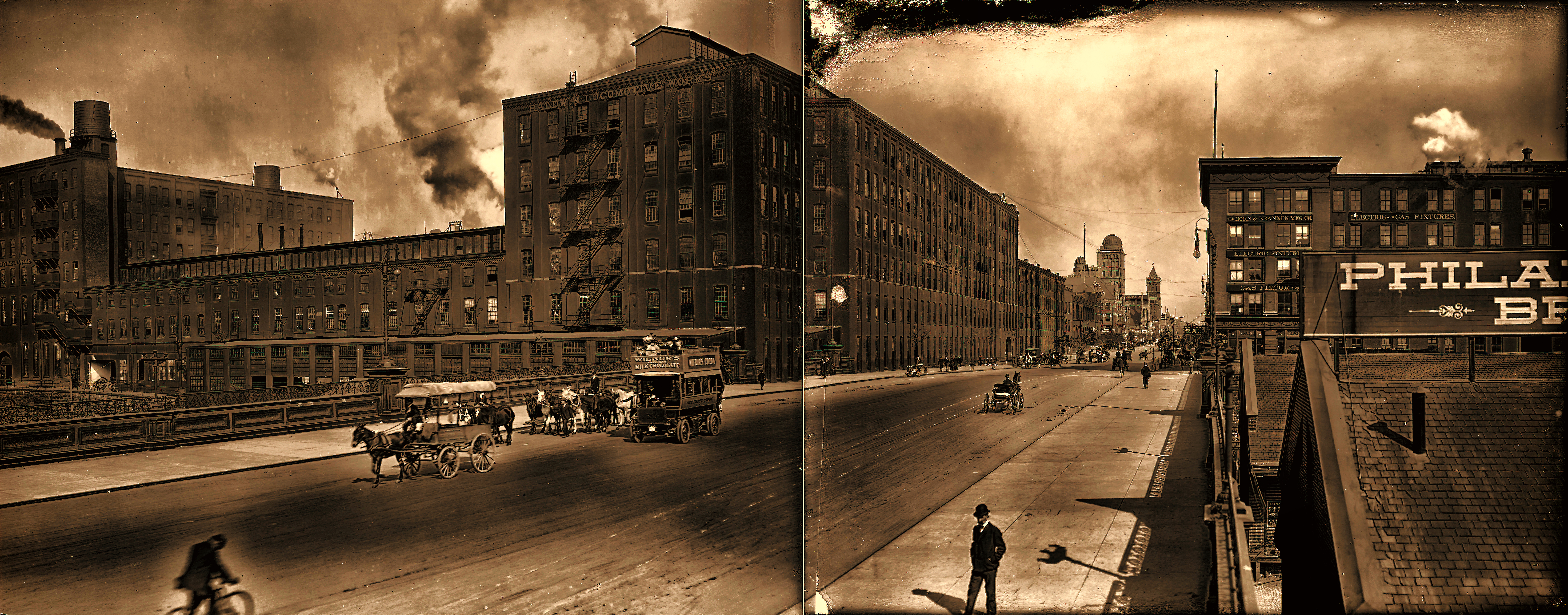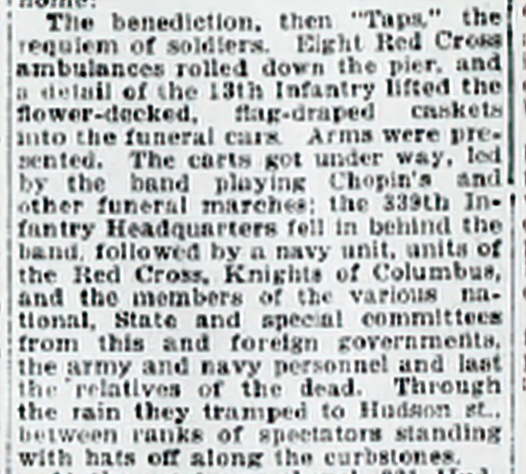
In the midst of all this life, what won’t die is the music


According to the Library of Congress’s annotation, these photographs are probably two parts of a three-part panorama: the left and the center, or perhaps the center and the right. The third panel isn’t in the Library, however, and Photoshop’s automated merge function can’t bring the remaining two any closer to each other. They appear to have been taken from positions different enough to create a continuity error. From one image to the next, the curb’s line breaks to form an angle and the Baldwin Locomotive Works undergoes a change of perspective. Just when time almost stopped for an instant at the beginning of the twentieth century, the instant’s vanishing point was seen to move and blur as if it were alive after all.

So the visual forms that survive in the blur survive only as isolated colonies of the perceptible: the contextless cloud of steam, its whites and shadows sharply delineated but its purpose in its moment no longer knowable; the man with his tilted derby and rakish posture and shadow, never again to be nameable; the women in hats propelled along a route to the margin, blurred to unreadability above the moving words Wilbur’s American Milk Chocolate.
But at the right, unmoving, PHILA. It is only part of a word, but we seem to remember what the remainder once said of itself in the presence of a now vanished camera. From memory, memory recites DELPHIA. The sound is reassuring, because it seems stable. Tomorrow it will still be callable to mind and singable to completion once more.
But half of its harmony will sing in silent dark, because DELPHIA is a word in the dead language of the vanished panel 3. Looking down now at the two remaining panels, we experience panel 3 as if within its own aftermath: understanding it like a schoolbook remembered but no longer readable with a child’s eye. At their image’s vanishing point, the shadows of the man on the sidewalk and the women in the brand new motorbus and the mule just ahead of them on the road are to become equally unseeable because light will have moved forward past the brink of the image and disappeared into time.
Note added April 2, 2021: in his February 13, 2012 blogpost at https://www.shorpy.com/node/12391, Shorpy succeeds in merging the two images seamlessly and also provides a comment stream from which we learn, among other things, that the electric bus seen on North Broad Street dates the panorama to 1907 or 1908. Thanks, Kim Bridges, for calling the Shorpy link to my attention.
In the port city of Hoboken, New Jersey, bodies are unloaded from a ship and transported through rain and words.

The words come from a two-column article on page 2 of The Brooklyn Daily Eagle for November 13, 1919: “Bodies of 111 U.S. Soldier and Sailor Dead Brought Home. Gallant Michigan Boys Gave Lives in Northern Russia — Impressive Ceremonies at Pier.” It includes the term “curbstones.”
If that plural and the phrase “gallant Michigan boys” read now like antiques, that is not the words’ fault. As of 1919, curbs actually were made of stone and the Michigan war writer Ernest Hemingway hadn’t yet begun publishing his deconstructions of words like “gallant.” But language change makes no allowance for changes in sensibility, and whatever it is that the words may once have represented is harder to feel now. In a cemetery in Michigan there is a war monument in the form of a polar bear,

but the episode of war that it commemorates is now all but forgotten in Michigan: the failed campaign of the American Expeditionary Force, North Russia, between 1918 and 1919. It is where the 111 men of rainy Hoboken met their deaths.
What you have been reading so far, then, in words and allegorical symbols, is a chapter in a history of the no longer wholly comprehensible. Somebody once wrote a marginal scholium on the chapter and called it “Dead Soldiers from Russia,” but it hasn’t integrated with the composition’s imagery. It is extrinsic. To its left, the composition has gone about the business of its rainy day by slow-dancing the hundred and eleven down a diagonal between the human matter of umbrellas (“Chopin’s and other funeral marches”) and the celestial matter of the rain, but the words in the black band don’t sing that music.

But in the rain the silent tree, leafless but living, curving itself down over the music and the dead in obedience to a lyric without words . . .

—
This memorandum about Bostonian style is copyrighted 1904, but in its right half it advertises some plays that opened in Boston in the fall of 1903: Lady Rose’s Daughter in November, The Earl of Pawtucket and A Hot Old Time in October. Elsewhere in the image are more equivocations. In the elevated train rolling through the Dudley Street station the motorman’s window is open but the passenger windows are shut, and at every point within the composition’s frame the sunny air is full of winter smoke. See how it is hazing over the sign atop Ferdinand’s Blue Store. You conclude these observations by making a weather report to yourself: Indian summer.
—
But every human image is reported in Indian Summer Time. If we could hear the words in the mouths of the pictured dead, the communication would consist only of gossip about that light-filled pause in the oncoming darkness. Its words would efface themselves as they reiterated their gossipy promise: “I must be going.”
But the words in the mouths of the dead – say, the dead half-lighted in this image: the group of women with a little girl in a big sailor hat, the man standing by himself down below – are not to be heard, even by the dead themselves. On Dudley Street in 1903, the dead were surrounded by walls covered with words addressed to them, but the instant those words became part of a photograph they became part of a foreign language: a language comprehensible only outside the image frame. On a low wall in a corner of the domain of the dead, its imaged advertisement for photographic supplies and processing is still decipherable, but it is no longer readable because to read is to enact a coming to life of meaning in a living mind. Because its text is addressed only to the dead, the photographic advertisement can no longer be anything but a photograph. We can’t read it; we can only see it. We are not yet in the picture. While Indian summer lasts, we are too alive.
—
You pick up the photograph and warm it in your hand. It depicts a noisy flock of electric railcars ringing and grinding their ways along steel. It is a historical proof of deducible noise, but it communicates that idea (“Noise! If you can’t hear it, feel it through your fingertips!”) only to the insensate dead. The Indian summer that it records has sunken fully into its no longer photosensitive surface. Its silvered paper integument has become the weatherproofed chronicle of a now silent season.
Sources:
“Dudley Street Station, Boston ‘L’ Ry., Boston, Mass.” Detroit Publishing Company Collection, Library of Congress, http://www.loc.gov/pictures/item/det1994000745/PP/. Photoshopped.
“The Boston Stage. Full Review of the Theatrical Season. An Alphabetical Record of Dramatic Works Performed in Boston During the Season of 1903-1904.” Boston Evening Transcript 16 July 1904: 24 and 23 July 1904: 45.
Crystal by crystal, the promise was made unbreakable. One sunny day in 1905, a Mr. Sam Atkinson offered to lift us down from our vantage in the sky and feed us a first class meal. Read now from an 8-by-10-inch glass plate spangled with silver halides by employees of the Detroit Publishing Company, the news of his offer is still spreading. Fixed to the glass by a chemical taxidermy, both Mr. Atkinson’s word and the firm wall that holds it up to the camera are now good forever. Within the borders of that plate, too, all of the land surrounding the word-upholding wall of Sam Atkinson’s St. Charles Hotel has become a containing plenum for the Atkinson transaction. Filled to overflowing with images of the first-class, it is a fertile earthen ware. Once upon a time a camera stopped to take on light from that vessel, and what entered the opening shutter then was receding perspective, cloud, blurry busy motion, traces of time cycling through the persistence of vision. For a fraction of a second, the camera recorded history going about its business of shaping its urn on the wheel.

Before the camera there also lay, once, a first class steamer, and athwart the gray city it was white. Sleek skin of a hot pulsing machinery, the white form moved into the camera’s field to mark the passage of a different color through life. Along such a passage, every voyage is an ascent. And once, a camera belonging to the Detroit Publishing Company was waiting in the sky for that ascent: prepared to receive the first class craft, make the liquid curve of its hull comprehensible as an image, and then lay it to rest on clear glass.
—
Sources
The photograph “Looking up Main Street, Buffalo, N.Y.” is in the Detroit Publishing Company collection in the Library of Congress, http://www.loc.gov/pictures/item/det1994011399/PP/, with copyright date of 1905 in the MARC record. However, the image reproduced above is the version photoshopped by Shorpy.com at http://www.shorpy.com/node/10659. Click it to enlarge. In detail, the sign looks like this.
